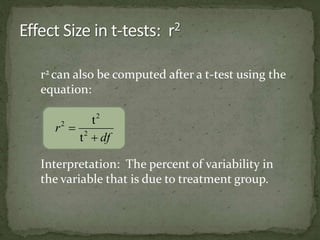The document discusses shared variance and effect size. It explains that shared variance, as measured by r-squared, indicates the percentage of variability between two variables that is explained by their relationship. Effect size can be measured by Cohen's d or eta-squared and indicates the size of the difference or amount of variability explained by a treatment group. Calculating measures of shared variance and effect size provides information about the strength and importance of relationships in statistical analyses beyond just significance.






